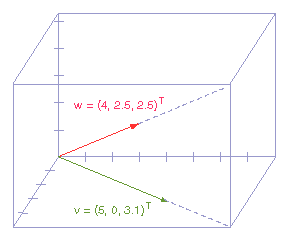My eyeball-estimate of the projection of w = (4, 2.5, 2.5)T onto v = (5, 0, 3.1)T is kv = (4, 0, 2.5)T

In this case, projecting w onto v involved "collapsing" the y dimension of w. Lets see if the same result comes out mathematically. The same steps work for 3D as for 2D:
So the visual estimate kv = (4, 0, 2.5)T matches the mathematical result, ( 4.00, 0, 2.49)T. The orthogonal vector can easily be computed:
Keep the same vector w as in the diagram. Visualize projecting w onto various vectors v'. Can you think of a vector v' that results in a projection kv' that collapses both the y and z dimensions of w ?